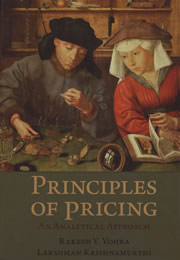Excerpted from Principles of Pricing: An Analytical Approach (Cambridge University Press, March 2012) |
In Principles of Pricing, Kellogg professors Rakesh Vohra and Lakshman Krishnamurthi explore the impact of pricing on profits
By Chris Serb ’09
Holding other things fixed, a 1 percent increase in price has more impact on profits than an equivalent increase in volume or decrease in costs. Yet managers frequently ignore price in their strategic decisions. That’s a big mistake, according to a new book by two Kellogg professors.
Principles of Pricing: An Analytical Approach, based on Rakesh Vohra’s lectures from his MBA course on pricing and on Lakshman Krishnamurthi’s experiences with Kellogg’s Executive Education program on Pricing Strategies and Tactics, aims to change managerial behavior that often relies on intuition rather than science.
"This is partly due to habit," says Vohra, the John L. and Helen Kellogg Professor of Managerial Economics and Decision Sciences. "Also, the need to respond to deadlines cuts into time for information gathering and reflection. This is the usual tension between immediate needs and long-term objectives."
One behavior the authors aim to dissuade is what they call the "sin" of cost-plus pricing, in favor of more sophisticated and profitable approaches such as Economic Value to the Consumer (EVC).
"Companies have data on costs, so a mark-up rule is easy to set up. Conducting competitive and customer level studies takes time and costs money," says Krishnamurthi, the Montgomery Ward Distinguished Professor of Marketing. "This is why companies frequently default to the cost-plus strategy."
Krishnamurthi notes that this strategy doesn’t only fail in the case of a new product like Crest Whitestrips, in which cost-plus would fail to capture the benefits of innovation, but also with established products like A1 Steak Sauce, which is made from the same commodities as its competitors but can price at a premium based largely on brand image and heavy advertising.
"Value includes both tangible components such performance and convenience as well as intangible components such trust and confidence and relationships, etc.," Krishnamurthi says. "So, EVC can help to quantify the convenience benefits of home teeth whitening and the intangible benefits of a dazzling smile, but is more helpful in B2B situations where the benefits are mostly tangible and can be quantified such as in the pricing of a medical device or construction equipment, etc. The message to managers: EVC is not difficult to do, and we have provided a step-by-step approach to carry it out."
This type of analysis is the hallmark of Principles of Pricing. Throughout the book, Vohra and Krishnamurthi explore all aspects of pricing through the lens of microeconomics and game theory. Topics explored include consumer response to a price; the economic theory behind the profit-maximizing price a monopolist can charge; different forms of price discrimination; and ways to price strategically in the presence of competition.
"What makes [Principles of Pricing] different from books currently on the market is that it has shock [and] horror equations," notes Vohra in his blog, The Leisure of the Theory Class. "I have to thank Lakshman for agreeing to such a foolhardy thing when we want to reach readers with an MBA or equivalent. Any decent MBA program requires some knowledge of probability, statistics and economics. Therefore, why write a book for this audience that does not make use of this knowledge? If we did, we are either hypocrites or contemptuous of our readers (or both)."
One key theme running through the book is that pricing should reflect strategy rather than intuition. That’s true whether you’re deciding how to set a price in the first place or how to react to a changing marketplace.
"You can only stick to your pricing strategy if you are confident about how you set prices in the first place," Krishnamurthi says. "Sticking to a pricing strategy does not mean not changing price, up or down. It means you have logic when you change price, which you can defend to the customer."



